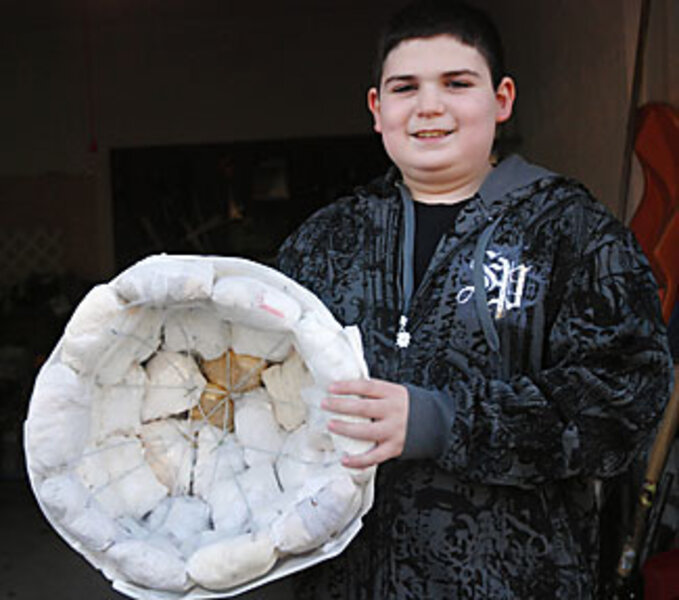From trash to an inventor's treasure trove
| Natick, Mass.
Max Wallack, who's 12, has been dreaming up ideas for new inventions since he was 6 years old. In his living room in Natick, Mass., the ninth-grader proudly displays his prize-winning inventions. Many of them were inspired by his grandmother and great-grandmother, two important role models in his life.
In one corner of the room, Max demonstrates what he calls the Great-Granny Booster Step, a wooden step with a handle, which his great-grandmother used to get into the family's minivan. It won top prize in the 2003 Craftsman/NSTA Young Inventors Awards Program.
He also explains the Walk and Wait Cane that he created. It's a cane with a foldout seat, so his great-grandmother could sit while she was waiting in lines.
Recently, Max entered another invention contest, the national Design Squad "Trash to Treasure" contest, and he won the grand prize!
But this time, Max had to do something a bit different – he had to dig through the trash to find ideas for his invention.
Max, one of five finalists ages 12 to 18, thought of new ways to construct something useful using discarded materials. For his winning idea, Max won a laptop computer and a $10,000 prize from the Intel Foundation.
The contest, which received more than a thousand submissions, was sponsored by the PBS reality TV show "Design Squad," the Intel Foundation, and By Kids For Kids Co. All contestants were asked to design an invention using trash that people would normally throw away.
Did you know that, according to the Environmental Protection Agency, people throw out an average 4.6 pounds of trash every day? About 1-1/2 pounds of it are recycled or composted. Reusing waste (or recycling) helps reduce the amount of trash that eventually ends up in landfills.
An idea takes shape
When Max was in Chicago to accept his prize for inventing the booster step, it bothered him to see homeless people living on the streets. In the years since, he never forgot about that, and it inspired him to create his latest invention: a shelter for the homeless made from discarded materials.
"I kept that image in the back of my mind, thinking I had to do something," Max says. "I thought I could use some Styrofoam [and plastic] bags, and put them in a dome shape."
To create a model for this shelter, which he calls the "Home Dome," Max constructed a wire frame and stuffed plastic bags with Styrofoam packing peanuts to form the roof. He also included a built-in bed in the shelter.
There are several good things about Max's invention: It will provide inexpensive and portable shelter for homeless people. And it's created from waste that is difficult to dispose of. He also found a new use for materials that would otherwise pile up in landfills.
Other creative inventions
Thinking of ways to reduce and reuse waste for an invention proved challenging for the four other finalists as well. All had to think creatively about their family's trash as a treasure trove.
For Sophia Viggiano, that was easy. The idea for her invention came to her while she was in the shower and the drain kept getting clogged. Instead of using chemicals commonly found in clog-removing products, Sophia decided to find an eco-friendly way to unclog her drain. Her idea: Use a piece of wire webbing and an old mattress coil to fish out foreign materials in the drain.
Other finalists were inspired to help family members. Rebecca Crandall searched through her garage to find items to build a gardening wagon for her dad. Using a discarded skateboard, a chair frame, and a cabinet, she fashioned a cart from scratch.
Some finalists harnessed the power of the earth. Kettner Griswold created a source of renewable energy by using rainwater from his home's gutters with a generator and chain links, both from an old motor scooter. The setup provides free electricity whenever it rains!
Samantha Hoar came up with a way that factories could reduce the amount of cardboard, energy, and time used to produce boxes of tissues. She used a CD spindle case to hold tissues, as an alternative to buying a new box.
One of the neat things about inventing is seeing your invention come to life. Max will have that opportunity soon. The Continuum development lab in West Newton, Mass., will soon build a life-size prototype (or model) of his Home Dome shelter.
Although he's won many contests, Max continues to work on new ideas. After school, Max heads to his family's garage – that's where all the inventing happens. Currently, he's working on inventions for five other contests, but he won't say what he's constructing – it's a secret! Shh!
So, what does Max like best about inventing?
Being able to help people, he says. "I just identify a need, and I think of some solution to this need."





